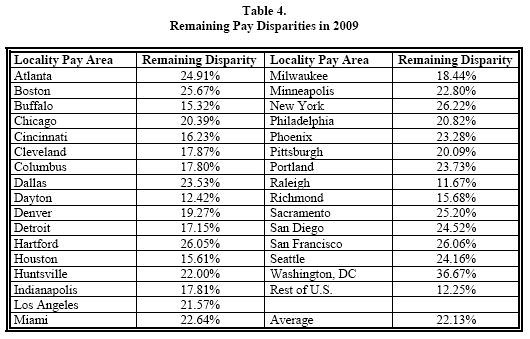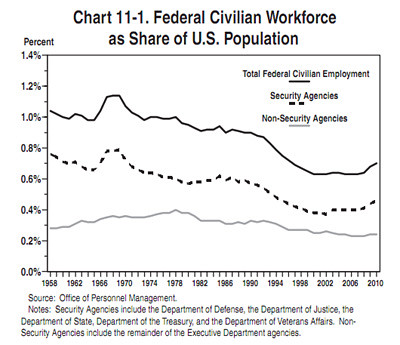Rolling out his plan to cut the national debt last week, Mitt Romney promised to "align federal employee compensation with the public sector." If so, the roughly 2.8 million federal workers whose pay has been frozen by President Obama can expect a big raise from President Romney. As the Bureau of Labor Statistics reported Friday, federal employees are now underpaid by 26.3 percent compared with similar non-federal jobs, a two percent increase over the previous year. And as it turns out, as a percentage of the total U.S. population, the federal workforce Romney wants to cut by 10 percent is already at its smallest since the 1950's.
For months, former Massachusetts Governor Mitt Romney has been at the forefront of the Republican crusade to demonize government workers as "freeloaders" and a "new privileged class in America." Regurgitating talking points from the right-wing Heritage Foundation and the Cato Institute, Romney declared that "average government workers are now making $30,000 a year more than the average private-sector worker." And in the plan to cut federal spending he unveiled last week, Romney took aim at Uncle Sam's workforce (see the video above, starting at the 5:50 mark):
Align Federal Employee Compensation With The Private Sector -- Savings: $47 Billion. Federal compensation exceeds private sector levels by as much as 30 to 40 percent when benefits are taken into account. This must be corrected.
As it turns out, not so much.
As the Washington Post reported Friday, the large and growing pay gap runs the other way:
The federal government reported Friday that on average its employees are underpaid by 26.3 percent when compared with similar non-federal jobs, a "pay gap" that increased by about 2 percentage points over the last year while federal salary rates were frozen.
As in the previous assessments of the numbers presented to the Federal Salary Council, federal workers are paid less than their counterparts in the30-plus metropolitan area surveyed, as well as the catch-all "rest of the US" (RUS):
The pay gap in the Washington-Baltimore area was calculated at 36.9 percent, slightly below the 38.1 percent reported last year...The gap in the locality with the largest number of federal employees, the catchall locality, was pegged at 19 percent, up from 14.7 percent. The overall average gap was calculated at 24.1 percent last year.
That persistent and growing gap hasn't prevented Republican mythmakers from claiming exactly the opposite. Consider, for example, the "2 to 1" claim now dominating the U.S media:
"The average federal employee makes $120,000 a year. The average private employee makes $60,000 a year." (Rand Paul)
"It's gotten to a point where the average federal worker makes twice as much as the average private sector worker." (John Boehner)
"Federal employees receive an average of $123,049 annually in pay and benefits, twice the average of the private sector." (Tim Pawlenty)
But as with state and local governments, this line of attack is an apples-to-oranges comparison at best and an outright deception at worst. As FactCheck pointed out:
The analysis is based on data from the Bureau of Economic Analysis and crudely done by dividing total compensation (salary and benefits) by the number of current federal civilian employees. Comparing such averages is quite misleading, for two reasons:
First, BEA says the figure is inflated by including compensation that is actually paid to benefit retirees, not just for current workers. The figure is at least several thousand dollars too high, by our calculations.
Second, the average federal civilian worker is better educated, more experienced and more likely to have management or professional responsibilities than the average private worker.
Over 44% of federal employees have a college degree, compared to about 19% of private sector workers. More importantly, an assessment of salaries (excluding benefits) by the Office of Personnel Management found that on average comparable federal civilian workers are paid 22 percent less than private workers. The disparities, even including incentive pay, are even greater in some metropolitan areas:
It is worth noting, as FactCheck does, that there are limitations to the OPM data. Not only are benefits not included, but the benchmarking methodology makes direct public/private section comparisons difficult. But as Sheldon Friedman, the chairman of the Federal Prevailing Rate Advisory Committee, pointed out last year, the absence of the apples-to-apples comparisons for health care and retirement benefits doesn't alter the larger conclusion:
"Certainly it is true on average the benefits in the federal government are superior to the average for the private sector workforce, but that workforce include many millions who probably have no benefits whatsoever," said Friedman. "If you are comparing an engineer at a GS-12 or 13 in the federal government with their counterpart with Boeing or any other private company, I would guess the benefits aren't that different. But we really don't know."
Regardless, Mitt Romney wants to take an ax to federal employees' compensation and, it turns out, the workers themselves. As Romney proposed last week:
Reduce The Federal Workforce By 10 Percent Via Attrition -- Savings: $4 Billion. Despite widespread layoffs in the private sector, President Obama has continued to grow the federal payrolls. The federal workforce can be reduced by 10 percent through a "1-for-2" system of attrition, thereby reducing the number of federal employees while allowing the introduction of new talent into the federal service.
Again, Mitt Romney's central claim is a false one. As the chart from the St. Louis Fed shows, federal government employment has been essentially unchanged under President Obama. (Ironically, Bill Clinton reduced Uncle Sam's workforce dramatically after the ballooning of the Reagan years.)
As it turns out, the federal civilian workforce is not only smaller now than during Ronald Reagan's supposed heyday of small government; as a percentage of the U.S. population, federal employment is near 50 year lows:
As it turns out, Romney's straw-man is just a slightly less deceptive version than the one his former presidential rival turned endorser Tim Pawlenty offered in December:
"Since January 2008 the private sector has lost nearly 8 million jobs while local, state and federal governments added 590,000."
It's with good reason Politifact branded Pawlenty's fabrication a "Pants On Fire" lie. With the temporary surge for the 2010 U.S. Census long since over, by the end of the 2010 the federal government's payroll had grown by a miniscule 34,000 over three years. Meanwhile, state and local governments have shed over 600,000 jobs since the recession started. (Nevertheless, conservative columnist George Will deemed the latest public sector job losses "good" while Republican Senate Minority Leader Mitch McConnell called them a "local" problem.)
McConnell's "local" problem includes the pay of state and municipal workers as well. A recent study by the Economic Policy Institute found a similar dynamic of underpaid government workers at the state level as well. Just one of many recent analyses debunking Republican charges about government workers and their unions, EPI found that "on average, state and local government workers are compensated 3.75% less than workers in the private sector." The report by Labor and Employment Relations Professor Jeffrey Keefe of Rutgers University revealed that public employees are undercompensated compared to similarly skilled private sector counterparts:
The study analyzes workers with similar human capital. It controls for education, experience, hours of work, organizational size, gender, race, ethnicity and disability and finds that, compared to workers in the private sector, state government employees are undercompensated by 7.55% and local government employees are undercompensated by 1.84%. The study also finds that the benefits that state and local government workers receive do not offset the lower wages they are paid.
The public/private earnings differential is greatest for doctors, lawyers and professional employees, the study finds. High school-educated public workers, on the other hand, are more highly compensated than private sector employees, because the public sector sets a floor on compensation. The earnings floor has collapsed in the private sector.
And compensation for state and local public employees is worst among the usual suspects. As the New York Times documented two weeks ago, state workers without a college degree generally make more than their private sector counterparts ($34,000 versus $32,000, or a 6.3% gap), while college graduates make much less (a -19.9% gap). But in the reddest of states, public employees experience a pay deficit regardless of education level. In Mississippi, the pay penalty for state workers without a college degree is 11.9%; for college graduates the deficit is 16.9%.
(Click here to see full size image.)
But that's just fine with Mitt Romney and his Republican colleagues who are so determined to lead a national race to the bottom. Their goal, it appears, is to make Washington DC - and the rest of America - look like Mississippi.
(This piece also appears at Perrspectives.)



















